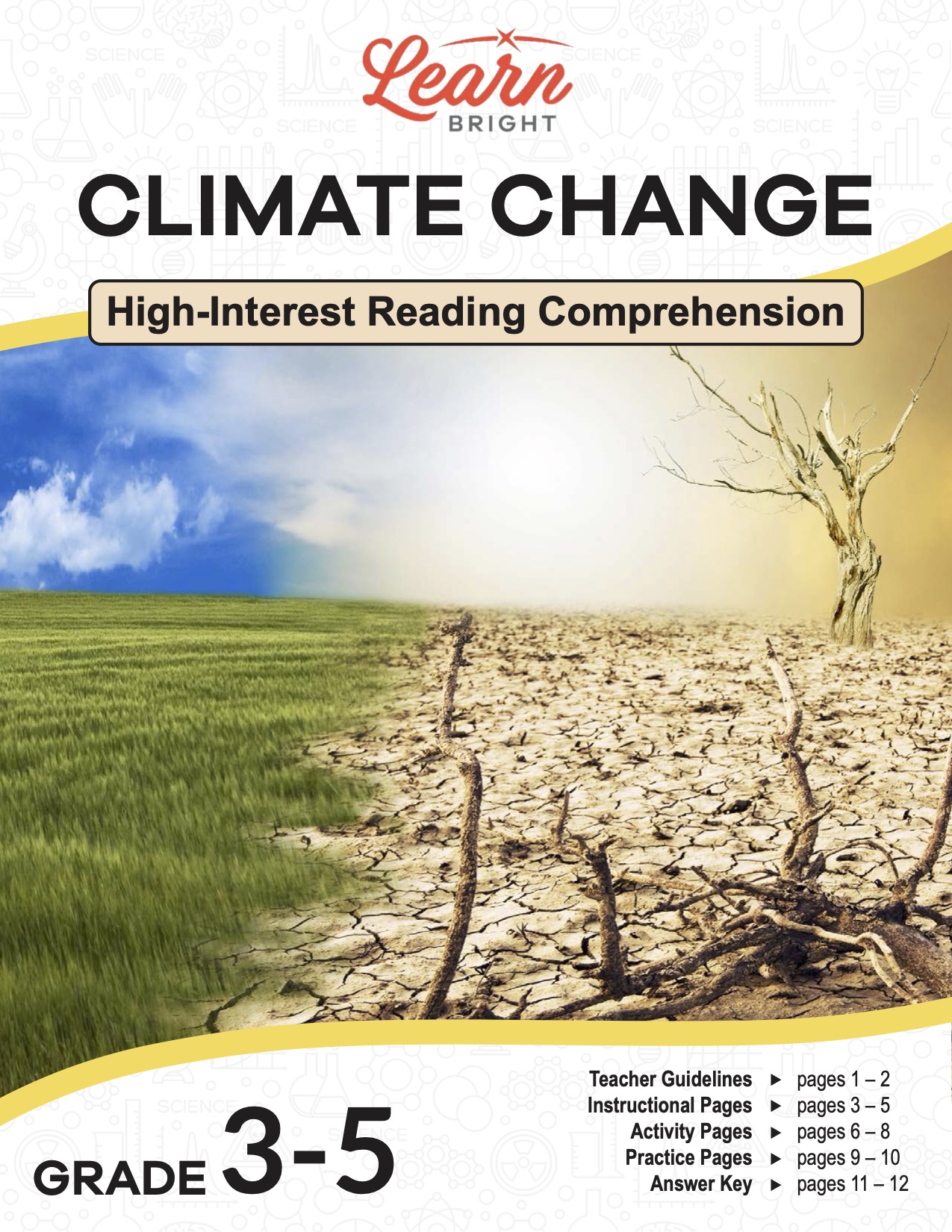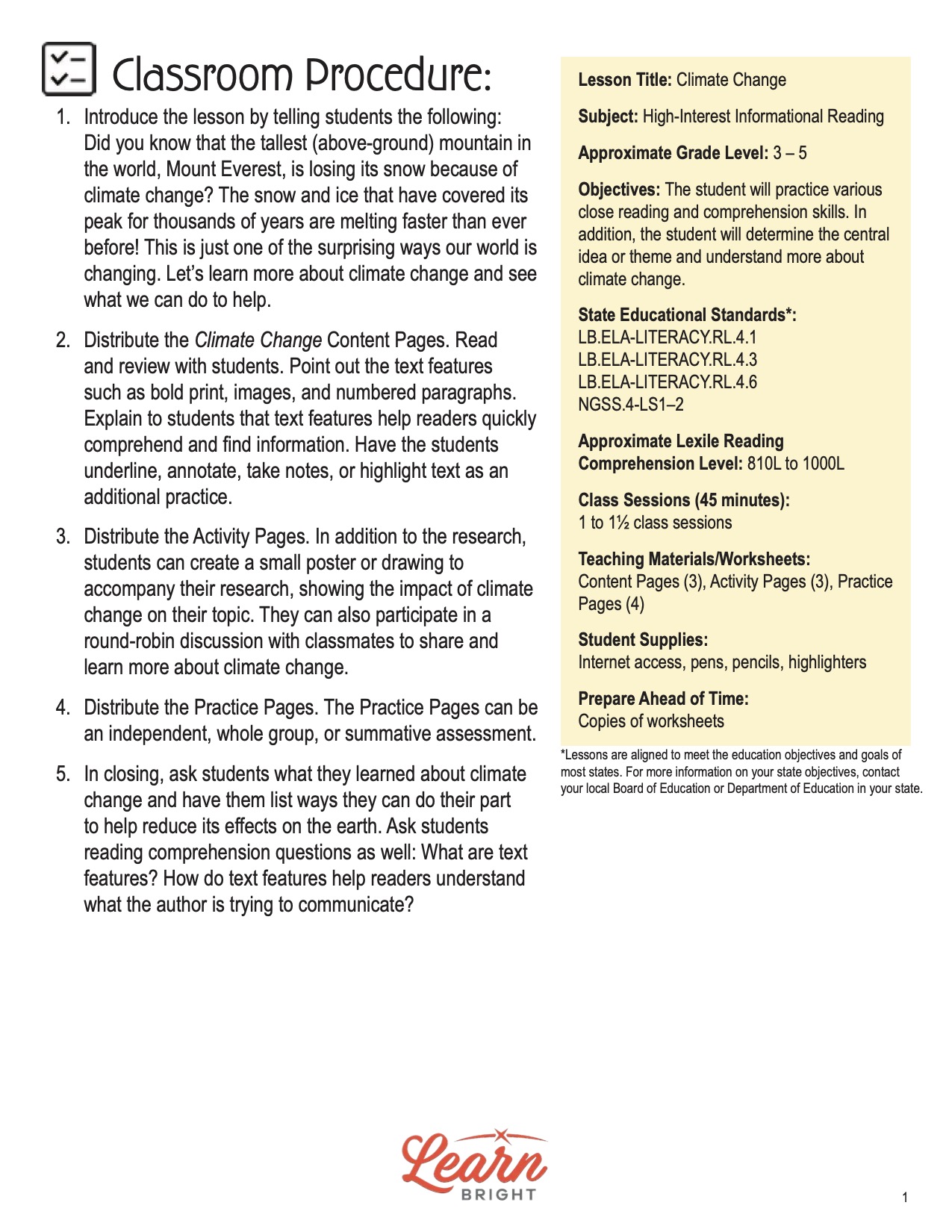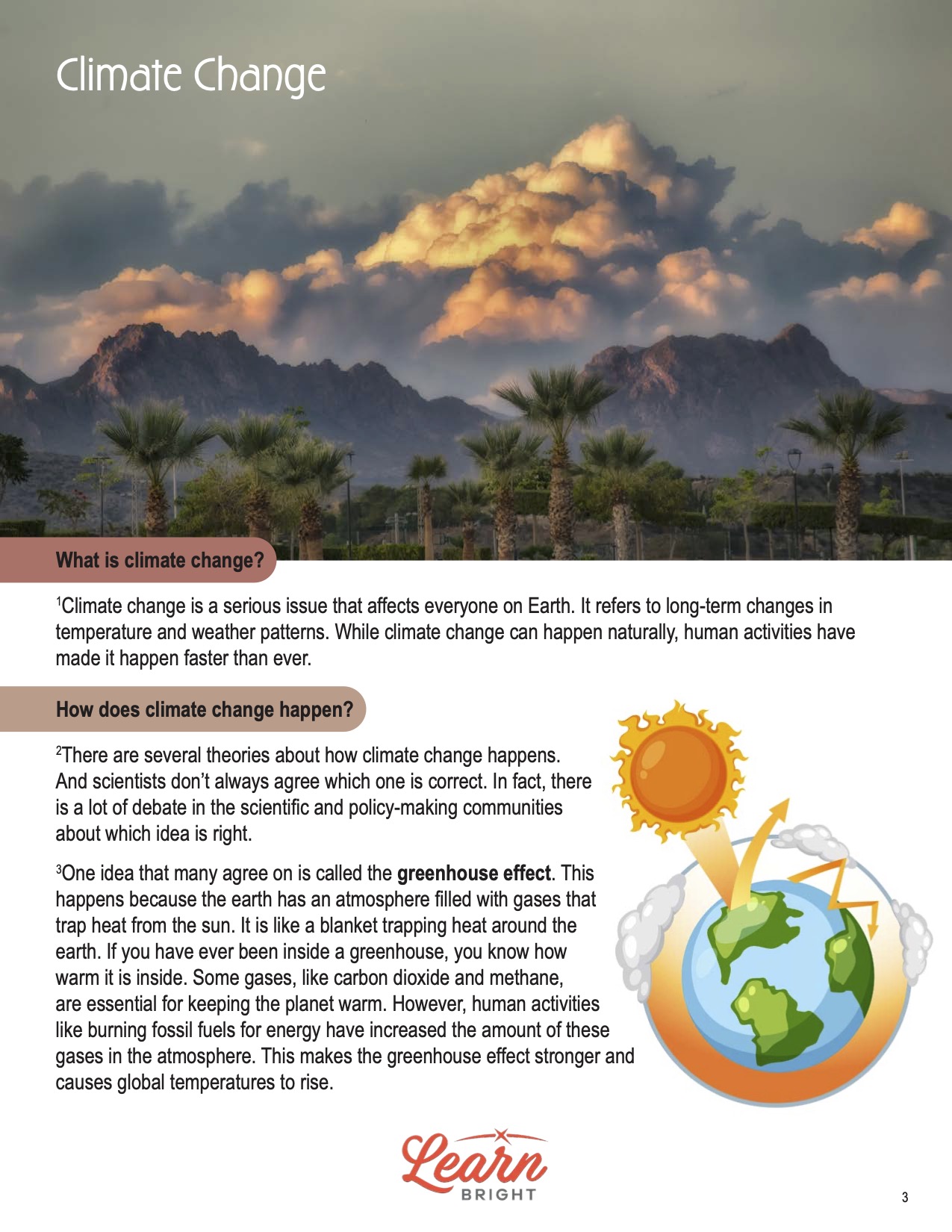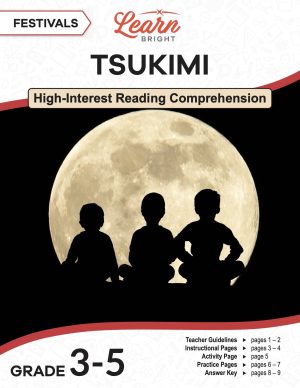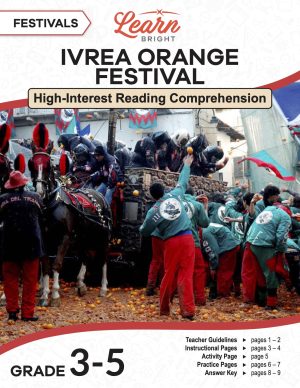Description
What our Climate Change lesson plan includes
Lesson Objectives and Overview: Climate Change is a high-interest reading comprehension lesson plan. As such, students will practice various close reading and comprehension skills. In addition, they will learn and understand more about climate change. This lesson is for students in 3rd grade, 4th grade, and 5th grade.
Classroom Procedure
Every lesson plan provides you with a classroom procedure page that outlines a step-by-step guide to follow. You do not have to follow the guide exactly. The guide helps you organize the lesson and details when to hand out worksheets. It also lists information in the yellow box that you might find useful. You will find the lesson objectives, state standards, and number of class sessions the lesson should take to complete in this area. In addition, it describes the supplies you will need as well as what and how you need to prepare beforehand.
Teacher Notes
The teacher notes page provides an extra paragraph of information to help guide the lesson and remind you what to focus on. It explains that you can teach this lesson in a whole-class setting or as an independent, small-group activity. The blank lines on this page are available for you to write out thoughts and ideas you have as you prepare the lesson.
CLIMATE CHANGE LESSON PLAN CONTENT PAGES
Climate Change and How It Happens
The Climate Change lesson plan contains three pages of content. Climate change is a serious issue that affects everyone on Earth. It refers to long-term changes in temperature and weather patterns. While climate change can happen naturally, human activities have made it happen faster than ever. There are several theories about how climate change happens. And scientists don’t always agree which one is correct. In fact, there is a lot of debate in the scientific and policy-making communities about which idea is right.
One idea that many agree on is called the greenhouse effect. This happens because the earth has an atmosphere filled with gases that trap heat from the sun. It is like a blanket trapping heat around the earth. If you have ever been inside a greenhouse, you know how warm it is inside. Some gases, like carbon dioxide and methane, are essential for keeping the planet warm. However, human activities like burning fossil fuels for energy have increased the amount of these gases in the atmosphere. This makes the greenhouse effect stronger and causes global temperatures to rise.
Causes and Effects
Scientists have identified the major difference between what is happening today in our climate and what occurred thousands of years ago. The burning of fossil fuels like coal, oil, and natural gas is one of the main differences. We use these fuels to power our cars, factories, and homes. When burned, they release large amounts of carbon dioxide into the air. Deforestation, or cutting down trees, also contributes to climate change. Trees absorb carbon dioxide, so when we cut down the trees, there is more carbon dioxide in the atmosphere. Other factors such as agricultural practices and waste production also add to the problem.
The results of climate change are alarming. As temperatures increase, more extreme weather events—hurricanes, floods, and heatwaves, for instance—happen more often. Melting ice caps and glaciers cause sea levels to rise, which threatens coastal cities. Additionally, many plants and animals struggle to adapt to these changes, leading to the extinction of some species. This loss of biodiversity can harm ecosystems and disrupt the balance of nature.
Who Can Help with Climate Change?
We can all probably agree that something is happening to the world’s climate. Focusing our attention on solutions and repairing ecological damage can help. Everyone can play a part in fighting climate change! People can reduce their carbon footprint by using public transportation, recycling, and conserving energy at home. Simple actions such as turning off lights when leaving a room or using reusable bags can make a big difference. Communities can come together to plant trees, support clean energy sources, and raise awareness about the problem.
Governments also play a role in addressing climate change. They can create laws and policies that limit greenhouse gas emissions and promote renewable energy. This includes investing in solar, wind, and other clean energy technologies. International cooperation is also necessary, as climate change is a global issue that affects all countries. The world needs to work together to share solutions and support one another in reducing their impact on the environment.
Many people and organizations work very hard to combat climate change. Environmental groups like Greenpeace and the World Wildlife Fund (WWF) advocate for policies that reduce greenhouse gas emissions and promote renewable energy. Local community organizations often organize tree-planting events and educational programs to raise awareness about climate issues. Together, these efforts show that individuals and groups can make a huge difference in the fight against climate change.
Why It Matters
It is important to understand why climate change matters. It affects our health, our environment, and our future. For example, increased air pollution can lead to respiratory problems and other health issues. Plus, climate change can affect food production, making it harder to grow crops and feed people. If we don’t act now, future generations may face even more significant challenges.
Climate change is a pressing issue caused by human activities that seriously affects our planet. Understanding how it happens, what causes it, and who can help will help us address the challenge. By making small changes in our daily lives, working together in our communities, and advocating for better policies, we can combat climate change and protect our earth for future generations. Every action counts, and no action is too small. Together, we can make a difference!
CLIMATE CHANGE LESSON PLAN WORKSHEETS
The Climate Change lesson plan includes two worksheets: an activity worksheet and a practice worksheet. Each of these handouts will help students solidify their grasp on the content. The guide on the classroom procedure page outlines when to hand out each of the worksheets to the class.
CLIMATE CHANGE AND THE PLANET ACTIVITY WORKSHEET
For this activity, students will pick a topic from the list on the page to research. Topics include polar bears, sea levels, hurricanes, migrating birds, and other subjects that relate to climate change and its affects. Students will answer several questions about how climate change affects the topic they chose. If you like, you could have students research in groups and present what they find to the class.
REVIEW PRACTICE WORKSHEET
The practice worksheet lists 10 questions based on the content. These questions all relate to the content pages, so students will need to refer to them often for the answers. In addition, each question provides which reading tool the question corresponds to, such as text feature, vocabulary, or comprehension.
Worksheet Answer Keys
At the end of the lesson plan document is an answer key for the practice worksheet. The correct answers are all in red to make it easier for you to compare them with students’ responses. If you choose to administer the lesson pages to your students via PDF, you will need to save a new file that omits these pages. Otherwise, you can simply print out the applicable pages and keep these as reference for yourself when grading assignments.

